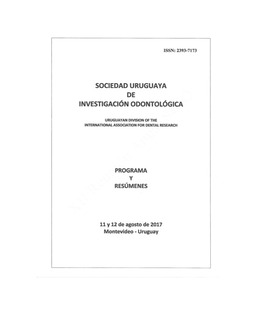| dc.contributor.author | Sakalian, María Candela | |
| dc.contributor.author | Rozas, Carlos Alfredo | |
| dc.contributor.author | Uribe Echevarría, Leonardo | |
| dc.contributor.author | Visvisían, Carmen | |
| dc.date.accessioned | 2022-11-15T12:15:48Z | |
| dc.date.available | 2022-11-15T12:15:48Z | |
| dc.date.issued | 2017 | |
| dc.identifier.issn | 2393-7173 | |
| dc.identifier.uri | http://hdl.handle.net/11086/29664 | |
| dc.description.abstract | OBJECTIVES: Comparing the sealing and adaptation to deep pulpal wall of different biomaterials used as dentin pulpal protectors using confocal laser scanning microscopy reflection (CLSMR) METHODS: Human molars with Class 1 preparations measuring 4x4x4 and performed using a Cavity Preparation Standardizing device were used (URIBE ECHEVARRIA L, 2014). Experimental groups were as follows: Grupo 1: EQUIA Fil, GC Corporation; Grupo 2: Biodentine, Septodont; Grupo 3: MTA White, Angelus; y Grupo 4: Dycal, Dentsply. The teeth were sectioned bucco-lingually using Isomet 1000, and polished using rotating polishing pads and 0.5 µm diamond particles for direct observation by CLSMR LEXT 4000. Interfaces at the pulpal wall were determined, and mean and standard deviation were calculated. The values were sujected to ANOVA Variance analysis and to the no parametric test Kruskal Wallis. RESULTS: Group 1 interface of 0,47 µm, ±0.2 in group 2 the interface were of 1,98 µm, ±0,15, in Group 3 the interface were of 17,58 µm, ±5,28 and in group 4 were of 24,54 µm, ±2,65. The non parametric test allowed to determine that there are statistically significant differences among the groups. Group 3 registered higher values than group 4, the differences between them were not statistically significant with p>0,05, showing these two groups statistically significant differences respect to groups 1 and 2 with p 0.01). Conclusions: The results made it possible to conclude that groups 1 and 2 presented minimal interfaces of 0.47 μm and 1.98 respectively with sealing of the dentinal tubules; while groups 3 and 4, the open interfaces presented a lack of sealing of the tubules. | es |
| dc.format.medium | Impreso | |
| dc.language.iso | eng | es |
| dc.publisher | Sociedad Uruguaya de Investigación Odontológica | es |
| dc.rights | Attribution-NonCommercial-ShareAlike 4.0 International | * |
| dc.rights.uri | http://creativecommons.org/licenses/by-nc-sa/4.0/ | * |
| dc.subject | Microscopy, confocal | es |
| dc.subject | Dentin | es |
| dc.subject | Biocompatible materials | es |
| dc.title | Sealing and adaptation of different biomaterials used in the protection of the pulpal dentin complex | es |
| dc.type | conferenceObject | es |
| dc.description.fil | Fil: Sakalian, María Candela . Universidad Nacional de Córdoba. Facultad de Odontología. Cátedra de Endodoncia A; Argentina. | es |
| dc.description.fil | Fil: Rozas, Carlos Alfredo. Universidad Nacional de Córdoba. Facultad de Odontología. Cátedra de Operatoria I A; Argentina. | es |
| dc.description.fil | Fil: Uribe Echevarría, Leonardo. Universidad Nacional de Córdoba. Cátedra de Operatoria Dental; Argentina. | es |
| dc.description.fil | Fil: Visvisían, Carmen. Universidad Nacional de Córdoba. Facultad de Odontología. Cátedra de Endodoncia A; Argentina. | es |
| dc.description.field | Otras Ciencias de la Salud | |
| dc.conference.city | Montevideo | |
| dc.conference.country | Uruguay | |
| dc.conference.editorial | SUIO | |
| dc.conference.event | XII Reunión De La Sociedad Uruguaya de Investigación Odontológica | |
| dc.conference.eventcity | Montevideo | |
| dc.conference.eventcountry | Uruguay | |
| dc.conference.eventdate | 2017-8 | |
| dc.conference.institution | Sociedad Uruguaya de Investigación Odontológica | |
| dc.conference.journal | XII Reunión de la Sociedad Uruaguaya de Investigación Odontológica - Uruguayan División of the International Association For Dental Research | |
| dc.conference.publication | Libro | |
| dc.conference.work | Resumen | |
| dc.conference.type | Congreso | |





